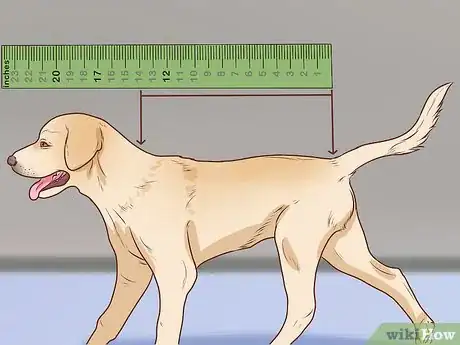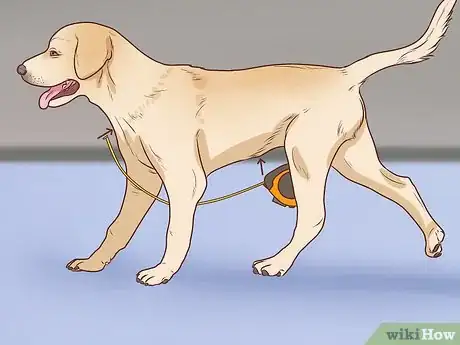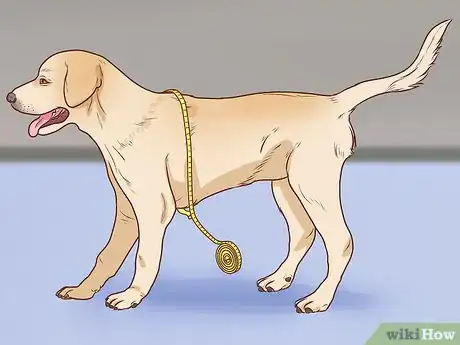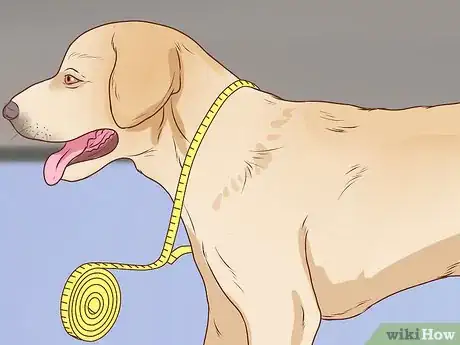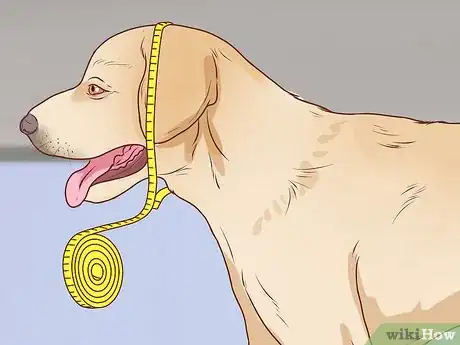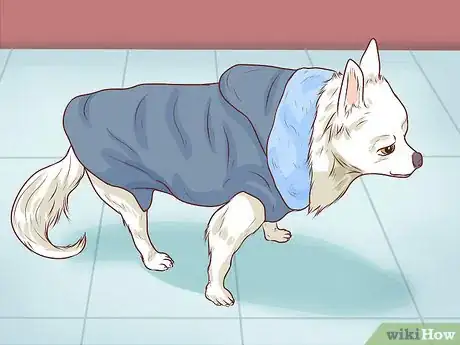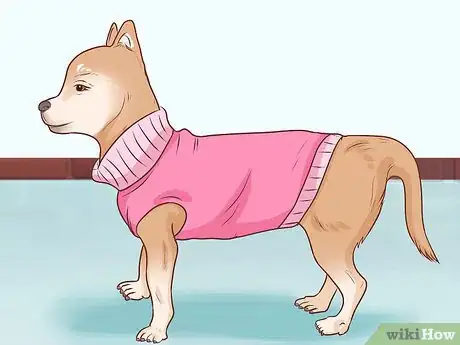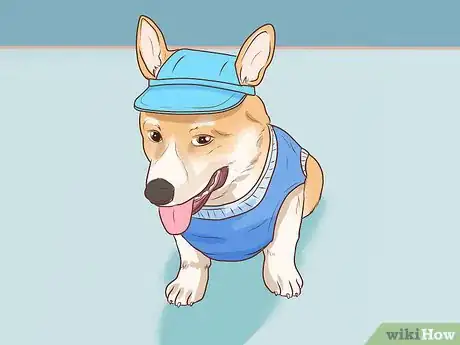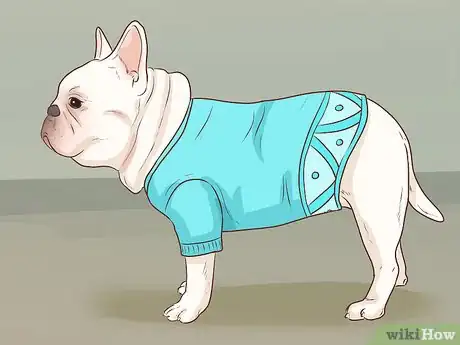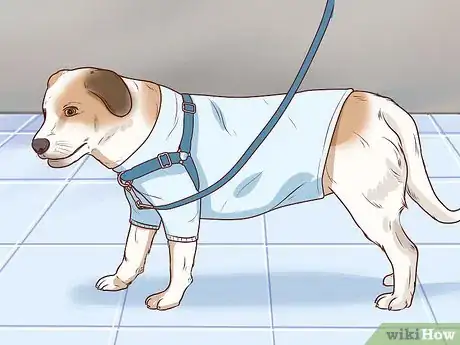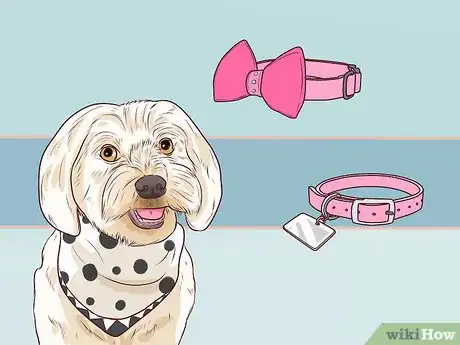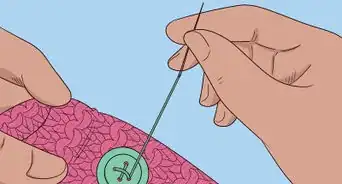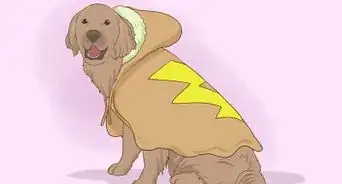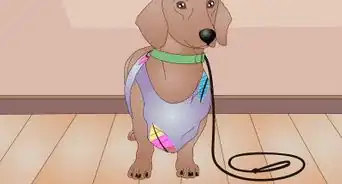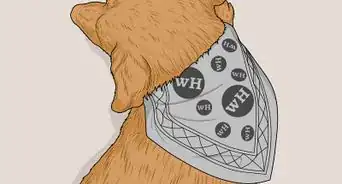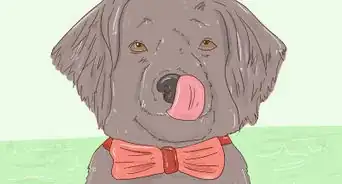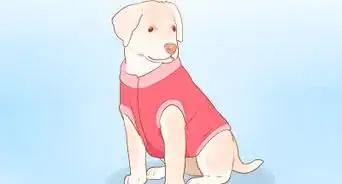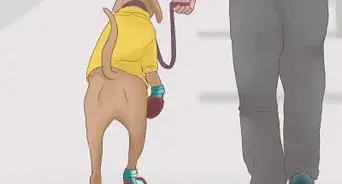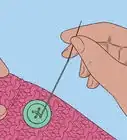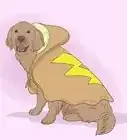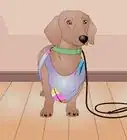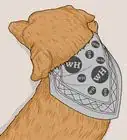This article was co-authored by Dani Pedraza. Dani Pedraza is a Professional Dog Trainer and a Co-Owner of The Big City Woof Walker with presences in NYC and Chicago. Dani is passionate about providing personal, quality pet service and treatment and is very knowledgeable about training dogs using positive reinforcement and a force-free approach. As a Certified Dog Trainer (CCDT), Dani graduated from CATCH Canine Trainer Academy’s Master Course program.
This article has been viewed 40,940 times.
Dog clothes are cute, and they can also be super functional. From sweaters, coats, and hoods that keep your pup warm in cool weather to harnesses to keep them safe on walks, it's important to get your dog's measurements right. Clothes that are too tight could cut off blood circulation, and clothes that are too loose could fall off or get tangled in their legs. All you need to get your dog's measurements is a soft tape measure and a pen and paper to write down the numbers. From there, you can buy, make, or order new clothes for your canine friend.
Steps
Getting Your Dog's Measurements
-
1Determine the top-line measurement for coats, sweaters, and shirts. The top-line is the length of your dog, measured from the base of their neck to where their tail starts. Take a soft tape measure and place one end at the base of your dog's neck and measure to the base of their tail. Use this measurement to figure out what size of clothing you should buy for them, or use it to make one-of-a-kind clothing yourself. Check out the following measurements to get an idea of what size sweater or coat your dog might need:[1]
- 6 and 1⁄4 inch (15.24 and 0.64 cm) = XXS
- 8 and 1⁄2 inch (20.3 and 1.3 cm) = XS
- 11 inches (28 cm) = S
- 13 inches (33 cm) = M
- 15 inches (38 cm) = L
- 17 inches (43 cm) = XL
-
2Get the measurement of the under-chest area to properly fit a sweater. Measure from the top of the dog's chest (the base of its throat in the front), bring the tape measure between its front legs and stop measuring at the end of the dog's rib cage. Really long dogs, (like dachshunds, basset hounds, and corgis) might need special sweaters with an extra-elongated under-chest area; otherwise, the sweater will end in the middle of their ribs and won't keep them very warm.[2]
- This measurement works for picking the right size of T-shirts, too.
Advertisement -
3Take the girth (chest) measurement to make sure straps will fit correctly. Use a soft tape measure to determine how big around your dog's chest is. Measure just behind the dog's front legs and up around the dog's ribcage. This is especially important if you're special-ordering a piece of clothing or if you're making clothes for your dog.[3]
- The girth measurement also comes in handy when picking out a harness for your pup.
-
4Measure the width of your dog's neck to fit collars and scarves. Take your soft tape measure and put it around your dog's neck, taking care to not pull it too tight. Measure from the top of the dog's chest, completely around its neck. Leave it loose enough so that you can easily fit 2 fingers underneath of it.[4]
- It's important for the collar (or scarf, bandana, or bowtie) to not be too tight, otherwise it could hurt the dog's windpipe or even cut off their airflow.
-
5Fit your dog for a hood by measuring around its head and down its neck. Place the soft tape measure in front of the dog's ears, bring it down around the jaws, and bring the tape measure around until it meets the end behind the ears. If the hood is going to be attached to a sweater or coat, also measure from the midpoint of the ears to the base of the neck to ensure that length of material will be big enough.[5]
Don't Forget: If you're making a dog hood yourself, remember to create holes for your dog's ears to peek through! They won't like it if their ears are pinned against their head.
Picking Different Types of Clothes
-
1Get a coat for your dog to wear in inclement weather. Protect your pup from rain, snow, and cold weather by outfitting them with a coat. Small dogs that don't have much body fat or thick fur will especially benefit from a coat in colder weather. Bigger dogs will love them if you're still taking long walks after the weather gets cool.[6]
- You could even get a raincoat to help keep your dog dry and warm and a separate winter coat for snowy, cold winter days.
-
2Keep your dog comfy at home with a sweater during cooler months. If you notice your dog has been extra cuddly in the fall and winter months, that may be because they need a little extra warmth! Get them a sweater to wear when the temperatures drop.[7]
- Sweaters aren't the best for dogs to wear outdoors if there is rain or snow, as the precipitation could absorb into the material and make them really cold.
- Avoid buying or making a sweater made of wool. The fabric is just as itchy to dogs as it is to humans.
-
3Pair your dog's outfits with hats and hoods to keep their face warm. Rain hats and warm hoods are great ways to keep your pup's face from getting too cold or wet when it's raining, snowing, or getting cooler outdoors. Use hats that are made specifically for dogs, make your own, or make alterations to a small hat you already have (make sure there are holes for your dog's ears to poke out).[8]
Tip: If your dog has never worn a hat before, start by having them wear it for just a few minutes at a time so they can get used to the feel. Never force your dog to keep a hat on if they are uncomfortable, and give them a treat when they do wear it.
-
4Put a cute T-shirt on your pup to make them look stylish. T-shirts don't provide much in the way of functionality—they don't keep your dog very warm or protect them from bad weather—but they are super cute! Pick the right size based off of your dog's top-line measurement and get ready for the compliments to start rolling in![9]
- If the shirt is too tight on your dog it could cause them to overheat. If you're in doubt about the sizing, pick the next size up.
-
5Select the right-sized harness to keep your dog safe on walks. There are a lot of different types of harnesses out there, from mobility harnesses to help you lift your dog if it needs it, to lightweight harnesses which are great for training purposes, to front-clip harnesses for dogs that tend to pull on their lead. Ask someone at a pet store to help you make a decision, or do some research to make sure you're picking the best harness for your pup.[10]
- Don't forget, if you have a puppy you will need to upgrade their harness from time to time until they are full grown.
-
6Add bowties, bandanas, and fun collars to your dog's wardrobe. Once you know the measurement for your dog's neck, you can pick out tons of great accessories for your pooch to wear. Always check to make sure you can fit 2 fingers underneath the collar so that your dog can breathe easily.[11]
- If your dog goes outside on its own, make sure it is always wearing a collar with an I.D. tag attached.
Expert Q&A
-
QuestionHow do I teach my dog to wear clothes?
 Dani PedrazaDani Pedraza is a Professional Dog Trainer and a Co-Owner of The Big City Woof Walker with presences in NYC and Chicago. Dani is passionate about providing personal, quality pet service and treatment and is very knowledgeable about training dogs using positive reinforcement and a force-free approach. As a Certified Dog Trainer (CCDT), Dani graduated from CATCH Canine Trainer Academy’s Master Course program.
Dani PedrazaDani Pedraza is a Professional Dog Trainer and a Co-Owner of The Big City Woof Walker with presences in NYC and Chicago. Dani is passionate about providing personal, quality pet service and treatment and is very knowledgeable about training dogs using positive reinforcement and a force-free approach. As a Certified Dog Trainer (CCDT), Dani graduated from CATCH Canine Trainer Academy’s Master Course program.
Professional Dog Trainer Desensitize them to putting the clothes on! You can do that in a very positive way by introducing them to the clothes and giving them a small treat; this way, every time you go to put the clothes on, you can slowly build up their comfortability with clothes. For instance, you might show the dog some boots and then give them a treat. The next step would be to hold the dog's paw up and give the dog a treat. From there, you would put the boot on, take it off right away, and give your dog a little treat. As you do this, you can build up to the point where your dog associates putting on the clothes with something really positive.
Desensitize them to putting the clothes on! You can do that in a very positive way by introducing them to the clothes and giving them a small treat; this way, every time you go to put the clothes on, you can slowly build up their comfortability with clothes. For instance, you might show the dog some boots and then give them a treat. The next step would be to hold the dog's paw up and give the dog a treat. From there, you would put the boot on, take it off right away, and give your dog a little treat. As you do this, you can build up to the point where your dog associates putting on the clothes with something really positive.
Things You'll Need
- Pencil or pen
- Paper
- Soft tape measure
References
- ↑ https://www.equinesuperstore.co.uk/beyond-the-paddock/guides/how-to-guides/measure-your-dog/
- ↑ https://www.equinesuperstore.co.uk/beyond-the-paddock/guides/how-to-guides/measure-your-dog/
- ↑ https://www.equinesuperstore.co.uk/beyond-the-paddock/guides/how-to-guides/measure-your-dog/
- ↑ https://www.equinesuperstore.co.uk/beyond-the-paddock/guides/how-to-guides/measure-your-dog/
- ↑ https://www.equinesuperstore.co.uk/beyond-the-paddock/guides/how-to-guides/measure-your-dog/
- ↑ https://www.gopetplan.com/blogpost/dressing-your-pet
- ↑ https://www.gopetplan.com/blogpost/dressing-your-pet
- ↑ http://www.vetstreet.com/our-pet-experts/teach-your-dog-to-wear-clothes?page=2
- ↑ http://www.vetstreet.com/our-pet-experts/teach-your-dog-to-wear-clothes?page=2
